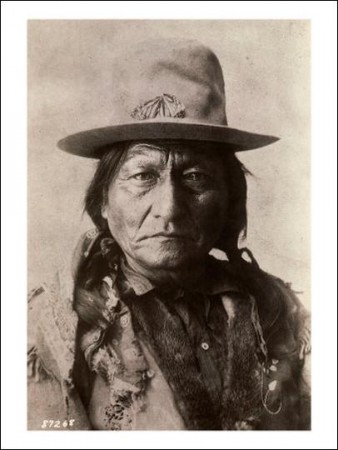A Hunkpapa Lakota chief and holy man under whom the Lakota tribes united in their struggle for survival on the northern plains, Sitting Bull remained defiant toward American military power and contemptuous of American promises to the end.
Born around 1831 on the Grand River in present-day South Dakota, at a place the Lakota called “Many Caches” for the number of food storage pits they had dug there, Sitting Bull was given the name Tatanka-Iyotanka, which describes a buffalo bull sitting intractably on its haunches. It was a name he would live up to throughout his life.
As a young man, Sitting Bull became a leader of the Strong Heart warrior society and, later, a distinguished member of the Silent Eaters, a group concerned with tribal welfare. He first went to battle at age 14, in a raid on the Crow, and saw his first encounter with American soldiers in June 1863, when the army mounted a broad campaign in retaliation for the Santee Rebellion in Minnesota, in which Sitting Bull’s people played no part. The next year Sitting Bull fought U.S. troops again, at the Battle of Killdeer Mountain, and in 1865 he led a siege against the newly established Fort Rice in present-day North Dakota. Widely respected for his bravery and insight, he became head chief of the Lakota nation about 1868.
Sitting Bull’s courage was legendary. Once, in 1872, during a battle with soldiers protecting railroad workers on the Yellowstone River, Sitting Bull led four other warriors out between the lines, sat calmly sharing a pipe with them as bullets buzzed around, carefully reamed the pipe out when they were finished, and then casually walked away.
The stage was set for war between Sitting Bull and the U.S. Army in 1874, when an expedition led by General George Armstrong Custer confirmed that gold had been discovered in the Black Hills of Dakota Territory, an area sacred to many tribes and placed off-limits to white settlement by the Fort Laramie Treaty of 1868.
Despite this ban, prospectors began a rush to the Black Hills, provoking the Lakota to defend their land. When government efforts to purchase the Black Hills failed, the Fort Laramie Treaty was set aside and the commissioner of Indian Affairs decreed that all Lakota not settled on reservations by January 31, 1876, would be considered hostile. Sitting Bull and his people held their ground.
In March, as three columns of federal troops under General George Crook, General Alfred Terry and Colonel John Gibbon moved into the area, Sitting Bull summoned the Lakota, Cheyenne and Arapaho to his camp on Rosebud Creek in Montana Territory. There he led them in the sun dance ritual, offering prayers to Wakan Tanka, their Great Spirit, and slashing his arms one hundred times as a sign of sacrifice. During this ceremony, Sitting Bull had a vision in which he saw soldiers falling into the Lakota camp like grasshoppers falling from the sky.
Views: 315



